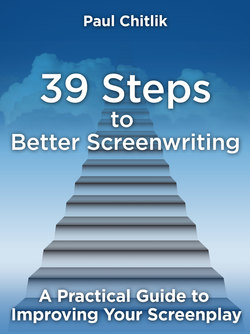Читать книгу 39 Steps to Better Screenwriting - Paul Chitlik - Страница 11
На сайте Литреса книга снята с продажи.
ОглавлениеStep 5
Writing (Not Overwriting) Descriptions We Can “See”
Here’s one of the basic contradictions a writer has to face. You know that a reader, probably not the producer, is going to be the first person at the production company or studio to read your script, so you have to impress this person. We know that motion pictures are all about what you see on screen, so you’d think that the descriptive passages of a script would be important. And they are. But readers often skip through them to get to the dialogue because they think, sometimes correctly, that the character is shaped by the dialogue. And dialogue is easier to read. But harder to write.
So, does that mean you shouldn’t pay attention to description? No. Does it mean that you shouldn’t write visually? No, on the contrary. You should still make the reader see the movie as best you can, and that’s where your writing style for descriptive paragraphs will pay off. But you may lose the reader’s interest if he or she has to plow through dense and long paragraphs. So, you want to make your paragraphs as short and succinct as possible.
No one has ever been accused of having too little description. Screenplays should be terse, filled with short phrases emphasizing verbs always — always — in the present tense.
Connor drags himself to the bed. Falls. Checks his arm. Blood spurts out of his wrist. He slams his other palm on it. Nearly faints.
Short declarative sentences. Fragments. Lots of verbs. But the scene is clear as a bell, isn’t it? You can see it, can’t you? You don’t need to know what kind of bed it is, or even what Connor looks like. You see the action, and that’s what counts. Let the makeup artist, the set designer, the production designer, the wardrobe designer, the director of photography, and the director fill in the rest. Let them do their jobs. Your job is to make them see the film, see the action, and move on.
Now take a five-line paragraph of description (and you know you have one) and turn it into two and a half lines. Take out thoughts, feelings, extra adjectives, adverbs, and even nouns if need be. Leave action words. Now compare it to the original. Isn’t it better?
